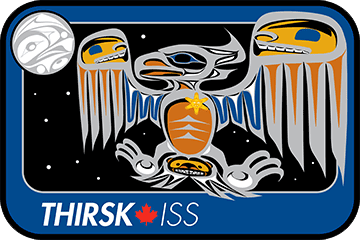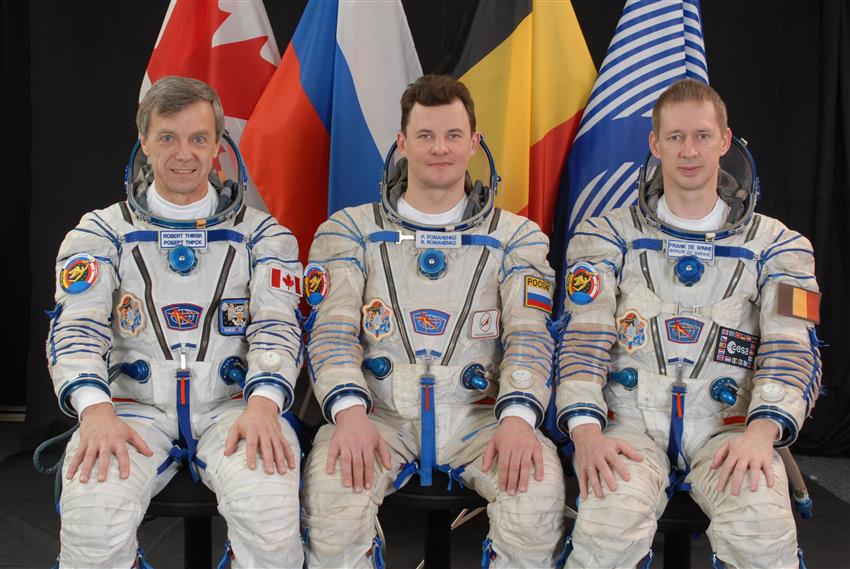Mission Expedition 20/21

Mission description

Text version
This patch commemorates Canada's first long duration Expedition onboard the International Space Station (ISS). Canadian Space Agency (CSA) astronaut doctor (Dr.) Robert Thirsk will live and work in the Station for six months. Robert is an admirer of Pacific Northwest Indigenous art, and is honoured that Bill Helin, a renowned Tsimshian artist has accepted to portray his mission through the use of several of its mythical figures.
The ISS has now become the largest and most powerful spacecraft in history. As viewed from above, the ISS resembles a great soaring bird. The legendary Thunderbird is a creature of great power and strength and is featured as the central element of this patch design. It resembles the near-complete Station during the mid-2009 timeframe.
Several of the structural components of the ISS are abstractly depicted by anatomical elements of the Thunderbird. The Space Station's eight solar arrays are depicted by the outermost large feathers of the Thunderbird's great outstretched wings. The inner triplets of smaller feathers represent the thermal radiators that provide cooling to the Station's onboard systems and astronaut inhabitants. The head and beak represent the modules of the Japanese and European partners. Canada's contributions to the international partnership, the ISS robotic manipulators, are represented by the curled appendages on the back of the head. The blue ovoid of the Thunderbird's eye indicates the location of the Node 2 docking port, where the new Japanese transfer vehicle, (HTV), will be berthed with the aid of Canadarm2.
Human faces adorn each wing. These faces are identical in form and kinship. One face symbolizes the astronaut crew in orbit, while the other symbolizes the large support team on Earth. The two faces gaze with trust and respect at one another in their common pursuit of the Expedition objectives. This unique partnership between the crew and the ground support team is the basis of the first Canadian Expedition.
A bear head is stylistically depicted within the tail of the Thunderbird and signifies the Russian portion of the Station. The tail feathers identify the four Russian modules including the Mini-Research Module 2 (MRM2) module that will be added to the Station in late 2009. The Thunderbird's two claws are outstretched and symbolize they are ready to grasp the American, Russian and Japanese spacecraft that will dock with the Station during the Increment 20/21 timeframe.
The torso of the Thunderbird represents the American Laboratory as well as the laboratories of the partner nations. The ribs represent the research racks and experiment facilities - the settings for innovative research in science, engineering and medicine. The knowledge gained from the onboard research activities during Increments 20 and 21 will benefit people on Earth.
A radiating Sun occupies the position of the heart within the Thunderbird's torso. As the most important aboriginal symbol of life, the Sun represents the enhanced life support system, which now provides the Station with the capability to support a crew of six astronauts.
The silver outline of the Thunderbird recalls the glistening exterior of the Station when sunlight sparkles off of its aluminum structure. The golden yellow and brown of the wings are similar in the coloration to the Station's solar arrays.
The head of a Raven is depicted within the Moon. In its partially-open beak is a sun disk. It was the cunning Raven, according to Northwest Coast native legend, who stole the sun from a box in a powerful chief's house many years ago and flung it into the sky to bring light to the world for the first time.
While the Thunderbird is revered as the chief of Earth's skies, he has the heart of an explorer. His gaze is directed toward the Moon. He yearns to explore new destinations in space and to undertake new adventures. Similarly the first Canadian Expedition aboard the ISS rekindles a national spirit of exploration. Our enhanced abilities to live and work in space will enable Canada to participate with other nations in the exploration of future destinations in space.
This patch was designed by Tsimshian artist, Bill Helin, a friend and supporter of the Canadian space program.
Patch Expedition 20/21. (Credit: Canadian Space Agency)
Launch
Date: May 27, 2009
Time: 6:34 a.m. EDT)
Site: Baikonur launch site, Republic of Kazakhstan.
Landing
Date: December 1, 2009
Time: 2:15 a.m. EDT
Site: Near the town of Arkalyk, Republic of Kazakhstan.
Mission duration: 187 days, 20 h 39 min
Flight number: Expedition 20/21
Orbiter vehicle: Soyuz rocket
In 2008, Dr. Thirsk was assigned to the crew of Expedition 20/21. This Expedition represents a milestone for the Canadian Space Program since it was the first time a Canadian took part in a long duration mission. Dr. Robert Thirsk had the privilege to expand the boundaries of space exploration by living and working on board the International Space Station (ISS) for six months. The launch took place on May 27, 2009 aboard a Soyuz rocket from the Cosmodrome in Baikonur, Kazakhstan.
During this long duration mission Dr. Thirsk assumed responsibilities for the maintenance and repair of the ISS, while conducting experiments on behalf of Canadian and international researchers.

Mission Expedition 20/21
From left to right: Robert Brent Thirsk, Roman Yurievich Romanenko and Frank De Winne. (Credit: Gagarin Cosmonaut Training Center)
The new great Canadian frontier
Since Russia launched Sputnik, the Earth's first artificial satellite in 1957, nation after nation has charted new territory for itself in space. In the spring of 2009, Canada will stepped up to the astronautical plate by combining technological sophistication, cutting-edge scientific research, international collaboration, and the passionate commitment of highly trained astronauts to push this nation towards and beyond a brave new frontier of exploration and scientific discovery.
On May 27, 2009, Canadian astronaut Dr. Robert (Bob) Thirsk launched in a Russian Soyuz vehicle from Baikonur, Kazakhstan, undertaking an unprecedented six-month stay on the ISS. Working with NASA (U.S.A.), Roscosmos (Russia), ESA (Europe), and JAXA (Japan), Dr. Thirsk and the Canadian Space Agency had the opportunity to demonstrate the foremost advances in Canadian technology, conducting valuable research experiments for national and international scientists, and bringing everyday Canadians closer to the experience of space than ever before.
Space milestones
Expedition 20/21 established a series of exciting benchmarks for Canada's space program. Dr. Thirsk was the first Canadian astronaut to live and work onboard the ISS for several months in a row- marking a milestone for Canada's Human Space Program. While previous missions have lasted no more than eighteen days, Dr. Thirsk lived and worked in the ISS for six months. In addition, he was the first Canadian astronaut to travel aboard a Russian Soyuz vehicle.
Internationally, this mission represented a significant leap forward in scientific collaboration aboard the ISS. Originally designed and constructed to house six astronauts, the ISS, to date, has provided residency to a maximum of a three-person crew on a permanent basis. Expedition 20/21, marked for the very first time that the ISS will be realizing its full potential: six astronauts living and working together in the world's largest orbiting microgravity scientific laboratory.
As a result, the international six-person crew—consisting of one Canadian, two Americans, two Russians, and one European—had more time than any astronaut before them to conduct scientific experiments in the unique environment of weightlessness. The science performed on Expedition 20/21 provided valuable information to scientists around the world, benefiting both the Canadian and international community.
Dr. Robert (Bob) Thirsk: astronaut, scientist, pioneer
During Expedition 20/21, Dr. Thirsk assumed many responsibilities. In addition to being appointed Crew Medical Officer, Dr. Thirsk was Mission Specialist for Kibo, the on-board Japanese Experiment Facility. He was also a robotics specialist, operating Canada's signature contribution to the ISS: Canadarm2. Finally, Thirsk's duty to perform scientific experiments and demonstrate new Canadian technologies led to advances in knowledge on behalf of the Canadian and international scientific community.
Science like never before
One of the ways in which Expedition 20/21 differed from all previous long-duration missions is the magnitude and scope of science undertaken on the ISS. Dr. Thirsk conducted at least seven Canadian experiments, one of which is in support of a student research project. The results of each study will have important implications for both spaceflight and life on Earth for all Canadians.
- Date modified: